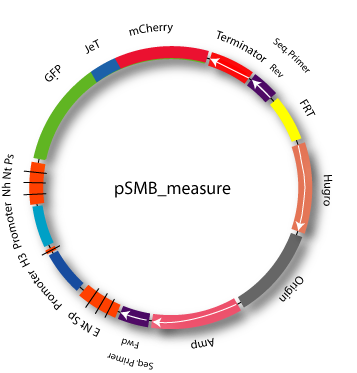Team:Heidelberg/Project dual assay plasmid
From 2009.igem.org
(Difference between revisions)
HannahMeyer (Talk | contribs) (→Dual Assay Plasmid) |
(→Introduction) |
||
| Line 13: | Line 13: | ||
=== Introduction === | === Introduction === | ||
| - | which should have the advantage of two fluorescent proteins with different promoters. One of them would be constitutive the other one to be tested. This construction would allow a standardized comparison of promoter strength, due to the elimination of different transfection efficiencies. Unfortunately the repeated cloning of the construct, which is shown in Fig 1, was not successful. | + | which should have the advantage of two fluorescent proteins with different promoters. One of them would be constitutive and the other one to be tested. This construction would allow a standardized comparison of promoter strength, due to the elimination of different transfection efficiencies. Unfortunately the repeated cloning of the construct, which is shown in Fig. 1, was not successful. |
| - | [[Image:Dual_plasmid.png|thumb|left|300px|<div style="text-align:justify;">''' | + | [[Image:Dual_plasmid.png|thumb|left|300px|<div style="text-align:justify;">'''Figure 1: The planned dual assay plasmid contained a site for promoter exchange, where one can put the promoter, that has to be tested. This promoter is upstream of a GFP gene and regulates its transcription. This gene is followed by a Jet promoter that constitutively promotes transcription of a mCherry, serving as a reference.</div>]] |
|width="250px" style="padding: 0 20px 15px 15px; background-color:#d8d5d0"| | |width="250px" style="padding: 0 20px 15px 15px; background-color:#d8d5d0"| | ||
|} | |} | ||
Revision as of 22:17, 21 October 2009
 "
"
